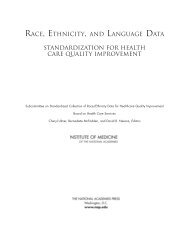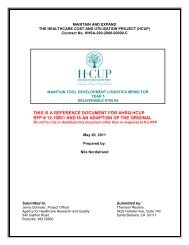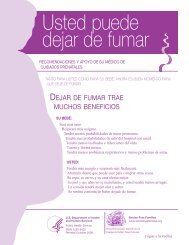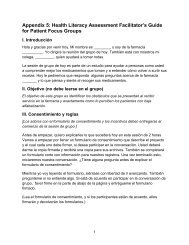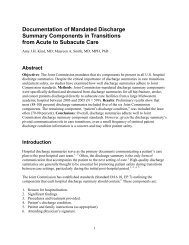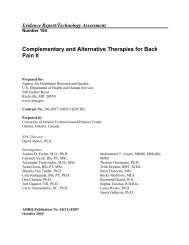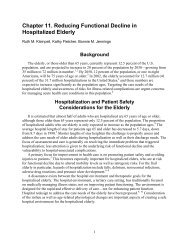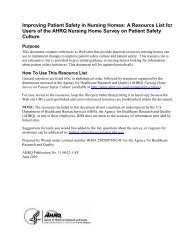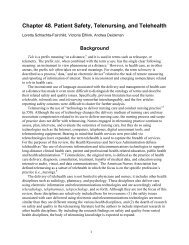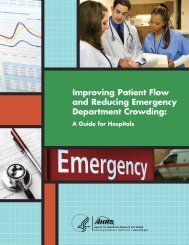Chapter 46. Magnet Environments for Professional Nursing Practice
Chapter 46. Magnet Environments for Professional Nursing Practice
Chapter 46. Magnet Environments for Professional Nursing Practice
You also want an ePaper? Increase the reach of your titles
YUMPU automatically turns print PDFs into web optimized ePapers that Google loves.
Patient Safety and Quality: An Evidence-Based Handbook <strong>for</strong> Nurses<br />
1. Institute of Medicine. To err is human: building a safer<br />
health system. Washington, DC: National Academies<br />
Press; 2000.<br />
2. Institute of Medicine. Crossing the quality chasm.<br />
Washington, DC: National Academies Press; 2001.<br />
3. Institute of Medicine. Keeping patients safe:<br />
trans<strong>for</strong>ming the work environment of nurses.<br />
Washington, DC: National Academies Press; 2004.<br />
4. Aiken LH. Improving quality through nursing. In:<br />
Mechanic D, Rogut LB, Colby DC, et al., eds. Policy<br />
challenges in modern health care. New Brunswick,<br />
NJ: Rutgers University Press; 2005. p. 177-88.<br />
5. Mick SS, Mark BA. The contribution of organization<br />
theory to nursing health services research. Nurs<br />
Outlook 2005 Nov-Dec; 53:317-23.<br />
6. Kazanjian A, Green C, Wong J, et al. Effect of the<br />
hospital nursing environment on patient mortality: a<br />
systematic review. J Health Serv Res Policy 2005<br />
Apr;10:111-7.<br />
7. White P, McGillis Hall L. Patient safety outcomes. In:<br />
Doran DM, eds. <strong>Nursing</strong>-sensitive outcomes: state of<br />
the science. Sudbury, MA: Jones and Bartlett<br />
Publishers; 2003. p. 211-42.<br />
8. McClure ML, Poulin MA, Sovie MD, et al. <strong>Magnet</strong><br />
hospitals: attraction and retention of professional<br />
nurses. Kansas City, MO: American Nurses’<br />
Association; 1983.<br />
9. McClure ML, Poulin MA, Sovie MD, et al. <strong>Magnet</strong><br />
hospitals: attraction and retention of professional<br />
nurses (the original study). In: McClure ML, Hinshaw<br />
AS, eds. <strong>Magnet</strong> hospitals revisited: attraction and<br />
retention of professional nurses. Washington, DC:<br />
American Nurses Publishing; 2002: p. 1-24.<br />
10. Shortell SM, Kaluzny AD. Health care management:<br />
organization design and behavior. 5th ed. Clifton Park,<br />
NY: Thomson Delmar Learning; 2006.<br />
11. American Nurses Credentialing Center. <strong>Magnet</strong><br />
Recognition Program: Application Manual 2005.<br />
Silver Spring, MD: American Nurses Credentialing<br />
Center; 2004.<br />
12. McClure ML. <strong>Magnet</strong> hospitals: insights and issues.<br />
Nurs Adm Q 2005 Jul-Sep;29(3):198-201.<br />
References<br />
10<br />
13. Lundmark VA, Hickey JV. The <strong>Magnet</strong> recognition<br />
program: understanding the appraisal process. J Nurs<br />
Care Qual 2006 Oct-Dec; 21:290-4.<br />
14. McClure ML, Hinshaw AS. The future of magnet<br />
hospital. In: McClure ML, Hinshaw AS, eds. <strong>Magnet</strong><br />
hospitals revisited: attraction and retention of<br />
professional nurses. Washington, DC: American<br />
Nurses Publishing; 2002. p. 117-127.<br />
15. American Nurses Association (ANA). Scope and<br />
standards <strong>for</strong> nurse administrators. 2nd ed.<br />
Washington, DC: Nursesbooks.org; 2004.<br />
16. Mark BA, Salyer J, Wan TT. <strong>Professional</strong> nursing<br />
practice: impact on organizational and patient<br />
outcomes. J Nurs Adm 2003 Apr; 33:224-34.<br />
17. Stone P, Pastor DK, Harrison MI. Organizational<br />
climate: implications <strong>for</strong> the home healthcare<br />
work<strong>for</strong>ce. J Healthc Qual 2006 Jan-Feb; 28:4-11.<br />
18. Kramer M, Schmalenberg CE. Best quality patient<br />
care: a historical perspective on <strong>Magnet</strong> hospitals.<br />
Nurs Adm Q 2005 Jul-Sep;29:275-87<br />
19. Kramer M, Hafner LP. Shared values: impact on staff<br />
nurse job satisfaction and perceived productivity. Nurs<br />
Res 1989;38(3):172-7.<br />
20. Aiken LH. Superior outcomes <strong>for</strong> magnet hospitals:<br />
the evidence base. In: McClure ML, Hinshaw AS, eds.<br />
<strong>Magnet</strong> hospitals revisited. Washington, DC:<br />
American Nurses Publishing; 2002. p. 61-81.<br />
21. Aiken LH, Patrician PA. Measuring organizational<br />
traits of hospitals: the Revised <strong>Nursing</strong> Work Index.<br />
Nurs Res 2000 May-Jun;49:146-53.<br />
22. Hinshaw AS. Building magnetism into health<br />
organizations. In: McClure ML, Hinshaw AS, eds.<br />
<strong>Magnet</strong> hospitals revisited: attraction and retention of<br />
professional nurses. Washington, DC: American<br />
Nurses Publishing; 2002. p. 83-102.<br />
23. Scott JG, Sochalski J, Aiken L. Review of magnet<br />
hospital research: findings and implications <strong>for</strong><br />
professional nursing practice. J Nurs Adm 1999 Jan;<br />
29:9-19.<br />
24. Abbott A. The system of professions: an essay on the<br />
division of expert labor. Chicago, IL: The University<br />
of Chicago Press; 1988.



